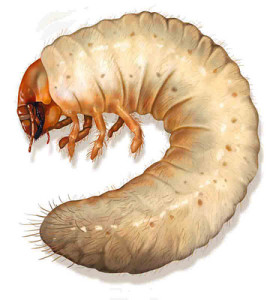White Grubs in Your Lawn?

White grubs are common pests of lawns and turf grasses in Ontario. The white grubs are the larval stage of three species of beetles (the June beetle or June bug, the European chafer and the Japanese beetle), which feed on the roots of grasses and other plants. This feeding results in the wilting and death of the grass in irregular shaped patches on the lawn. The wilted grass can be easily pulled free due to the destruction of the root system.
How Do I Know if Our Lawn Has Grubs?
- Skunks and raccoons will pull back the turf to feed on grubs in the spring or fall.
- Flocks of birds such as starlings, flickers and blackbirds feeding on the lawn are also signs of a grub infestation.
- As the roots are eaten, the turf will begin to wilt and turn brown.
- Affected areas will feel soft and spongy to walk on.
- Turf in affected areas can be pulled back and up with ease, like a carpet. Once you pull back the turf the grubs will be visible.
If you notice any of these issues in your lawn, make sure you check for white grubs. If you suspect that you have grubs, please call Dutch Style Landscaping before any significant damage starts to occur.
Life Cycle of the White Grub
Knowing the life cycle of white grubs is the key to determining whether you have a problem, what to do about it, and when to do it. A white grub is the immature (larval) form of a scarab beetle, such as a June Bug, European chafer and Japanese beetle. Grubs live in the soil, feeding on plant roots, so you may not be aware of them until you see damage. By considering a grub’s life cycle, you can anticipate problems before your lawn is ruined.

How Can I Prevent Grubs from Invading My Lawn?
Cultural practices are the best way to ensure the health of your lawn before any problems arise. A strong and healthy lawn can tolerate more grub feeding than a stressed lawn because damage to one root is compensated for by others. Healthy lawns will also have strong leaf tissue that will provide important nutrients and energy to repair the root damage. Deep and infrequent watering will encourage deep rooted and drought tolerant lawns. Make sure that you are fertilizing your lawn on a regular basis. Topdressing and seeding your lawn in the spring and fall is also highly recommended. When choosing a seed make sure to use grasses containing an endophytic fungus such as fescues and rye grasses. This type of fungus naturally repels white grubs.
How Can I Control White Grubs in the Lawn?
One completely natural pest control that is currently available is “Beneficial” Nematodes. These microscopic worms enter the Grub, release bacteria, reproduce in the host, and kill it. The Nematodes then vacate the dying insect and seek a new host. All vertebrates (humans, dogs, birds, etc.) are completely resistant to nematodes as are plants, earthworms, and helpful insects like bees and ladybugs.
Nematodes are best applied to your lawn when the soil has warmed up, but is moist.
Once the Nematodes have been applied, they will move quickly through the pre-moistened soil. Keep your lawn moist during the summer as the Nematodes require a film of water in which to move and infect target insects. The Nematodes will survive for up to 15 months. A fresh application will be needed following that.
Keep applying Nematodes for 2-3 years until you are confident your lawn is Grub-free.
Regular applications of fertilizer will keep your grass strong and increase root production. Minimize thatch build-up so that fertilizer, water, and air can pass into the root zone easily.
Keep your lawn well watered with 1″ – 1.5″ of water per week. If your life is too hectic, consider installing an irrigation system so you can set a timer for regular intervals.





Leave a Reply
You must be logged in to post a comment.